At the moment, Barcelona are still a wounded giant struggling to keep up with the competitiveness of La Liga. Ronald Koeman has a difficult job of getting them back to winning ways but that task is easier said than done.
However, despite the new coach restoring some of that faith in the youth, as seen from the resurgence of both Ansu Fati and Pedri, some other young talents haven’t been as lucky. Riqui Puig, for example, has been cast away by the Dutchman and has been unable to regain a spot in the team so far.
For a talent that Cesc Fabregas said could ‘become like Iniesta’ if given enough trust in the interview with RAC1 (via Tribuna), this is quite surprising, to say the least. But does the youngster deserve more than he’s currently getting by the new coach and could he be the solution to Koeman’s crisis?
This tactical analysis will aim to answer that question by looking at Puig’s traits and through analysis in a scout report, see how they could aid Barcelona’s tactics in their battle against Real Madrid and co.
Identifying the problem & the solution
At the moment of writing, Barcelona are sitting fifth in La Liga table with league leaders Atlético Madrid 10 points ahead of them and with a game in hand. For a team of the Blaugrana’s stature, this is a weird position to be in. However, when it comes to the very core of their problems, that lies in poor finishing.
Barcelona lead the Spanish top-flight in terms of expected goals with 33.8 after 16 games but have only managed to score 27. This means they are heavily underperforming and are lacking lethality in front of goal. Similarly, they lead the line in shot-creating actions (28.53 per 90) and are second in goal-creating actions (2.67 per 90). According to the data, creation is not as big of a problem, finishing is.
Having lost Luis Suárez to Atlético Madrid, never replacing him properly, and Antoine Griezmann not filling in his shoes adequately, Barcelona are suffering in front of goal. But the issue is that apart from the obvious, albeit at times diminished, presence of Lionel Messi, the Catalans lack any real goal threats in the team. So how does Puig solve this issue?
The young midfielder is not a big goal threat by his sheer presence but does seem to have a unique player profile that could further boost Barcelona’s chances. Below is a graph that involves the whole squad with their stats for the last calendar year. The reasons we’ve gone with the calendar year as opposed to 2020/21 is because it gives us a much bigger sample to analyse.
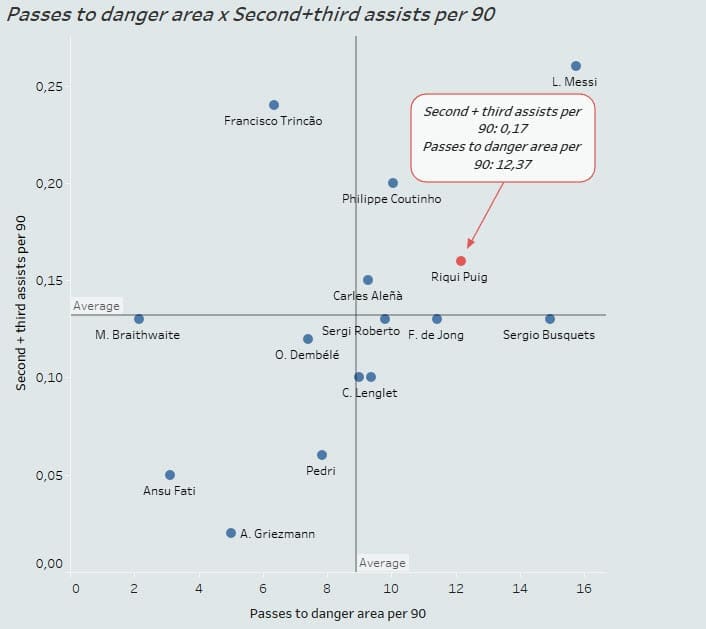
Above is a graph that depicts Barcelona’s best passers into the danger area (final third + penalty area) as well as players who deploy the most second and third assists per 90 minutes. We can see that alongside Messi and Philippe Coutinho, Puig, and intriguingly Carles Aleñá, are the only players to feature in the top right quadrant, meaning they excel in both categories.
We can instantly see that Barcelona lack that type of a player, especially in midfield, who is heavily involved in the creation but also assists the build-up as much as Puig does, for example. This is then further cemented by the following graph you can see down below.
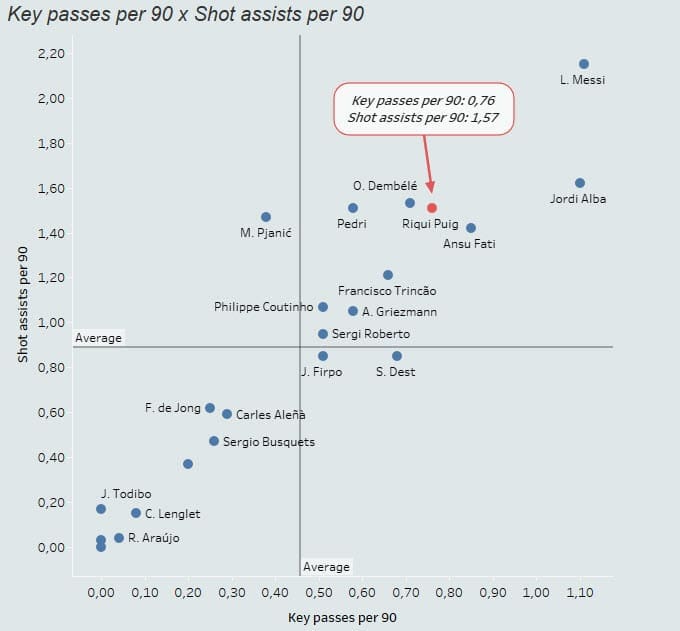
This time, we’re focusing on key passes per 90 and shot assists per 90. While it seems like the situation with these two metrics is much better when it comes to available personnel, Puig is once again among the best players in the graph.
Only Messi, Ansu Fati and Jordi Alba have registered more key passes per 90 in the last calendar year while only Messi and Alba are significantly better than the youngster in shot-creation as well. But note how Puig is the only midfielder in the upper right quadrant, followed by Pedri.
We can immediately conclude they both offer something unique whenever they’re on the pitch, which is confirmed by a closer look at their respective heatmaps in comparison to Frenkie de Jong and Coutinho.
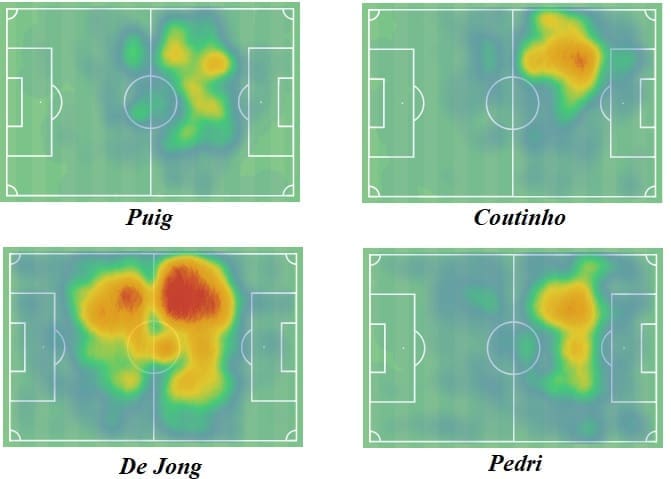
The image above essentially confirms that Puig and Pedri have similar tendencies on the pitch, which could mean Koeman usually has to choose between the two. But even with that being said, it’s strange that he opts to discard the former every time. Be that as it may, we can see that Puig’s movement is different and more proactive than Coutinho’s and at the same time, drastically different from De Jong’s.
This is important because apart from Barcelona suffering from ineffective finishing, they also struggle with unlocking low blocks and inefficient passing. This is where a dose of unpredictability, quick thinking, decisive passing and movement can help immensely. After dealing with the statistical comparisons, this tactical analysis will now deal with the three most important traits Puig can offer Koeman’s Barcelona:
- Destabilising a block via movement and positioning
- Offering late runs into the box
- Accelerating the play through the pass & move strategy, scanning and disguised passes
Note, however, that these are often used in combination and not as isolated cases and will therefore be covered as such in the following sections of the analysis.
Low block destabilisation
Dismantling a compact block is an extremely difficult job but Puig is effective because of his ability to recognise where to position himself and also to immensely accelerate the ball recycling. Let’s explore a couple of examples to see how he achieves this.
The first sequence of play is a rather simple one. Puig is initially positioned between the lines as Barcelona face a tight 4-5-1 defensive structure. The youngster drops closer to the backline, immediately activating the opposition’s second line and creating pockets of space while also disrupting the overall shape.
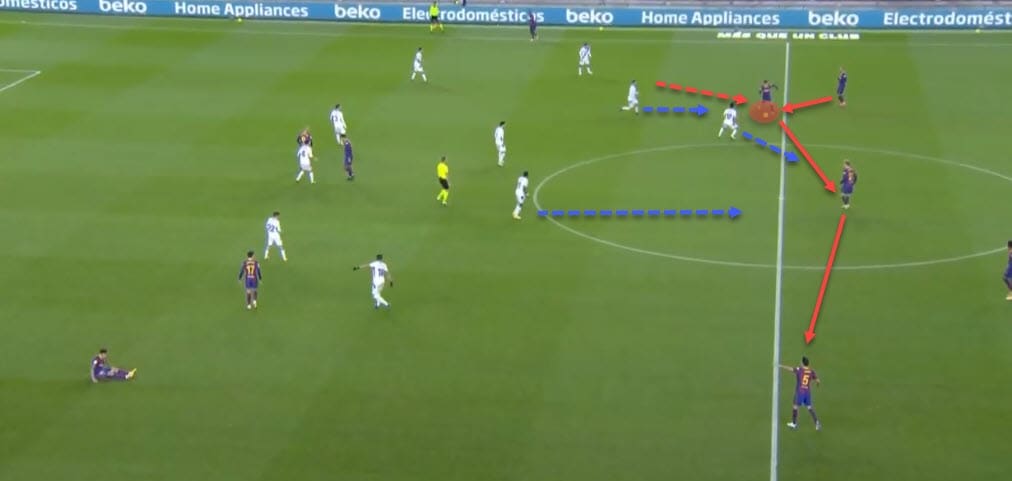
The next move is simple as he just relays the ball to De Jong who then finds Sergio Busquets on the other side. Note below how the whole defensive block is now shifting and Puig is immediately on the move, looking to position himself in an optimal pocket where he can receive the ball unmarked.
First, he scans for potential defenders jumping out of their shape to mark him but with the aid of his teammates who help him stay unmarked, Puig finds an ideal position to receive and progress immediately. Note, however, that Busquets opts for a switch of play in this scenario instead but this example still serves the purpose of showing us how Puig thinks on his feet.
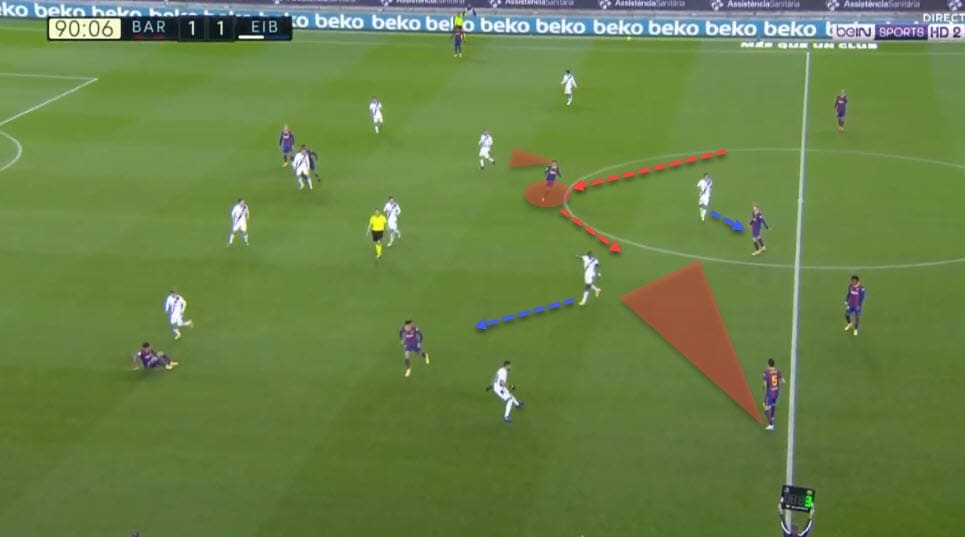
Scanning is obviously a huge part of the equation simply because it means Puig knows his next move even before receiving the ball. We’ve seen from his heatmap that he loves to position himself between the lines and then instantly turn to advance with the ball.
This works excellently to destabilise a low block because it forces the opposition into a decisional crisis, making them choose between breaking their defensive shape and leaving a dangerous player unmarked. A compact unit, however, will aim to shut off all and any passing channels towards that area and a lack of a penetrative passer could harm the team significantly.
But Puig is always on the move, trying to make himself available at all times. Note below how he moves out of the shadow of the defenders, opening a passing channel for Miralem Pjanić to exploit and break the lines. At the same time, the youngster immediately scans for his next move.
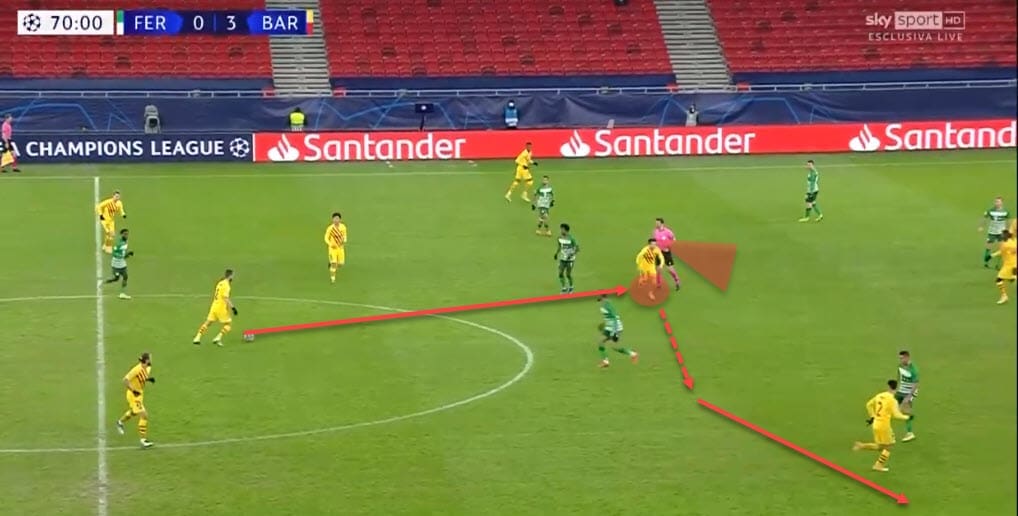
Once he’s out of the cover-shadow and found by a through pass, Puig proceeds to run with the ball towards the flank and switch the play to the right wing within seconds. This accelerates the play immensely and keeps Barcelona as proactive as possible.
Scanning & body positioning
We’ve already touched upon Puig’s scanning a bit in the previous section but as mentioned earlier, all of these aspects come as a package so one is often accompanied by the other. Here, we’ll talk about his body positioning that enables him to accelerate play as much as he does.
Receiving the ball is an art of its own and it decides how effective the player’s next move will be. In Puig’s case, it can help Barcelona speed up the tempo and progress while the opposition’s structure is still in disarray. Let’s explore it a bit further in the next couple of examples.
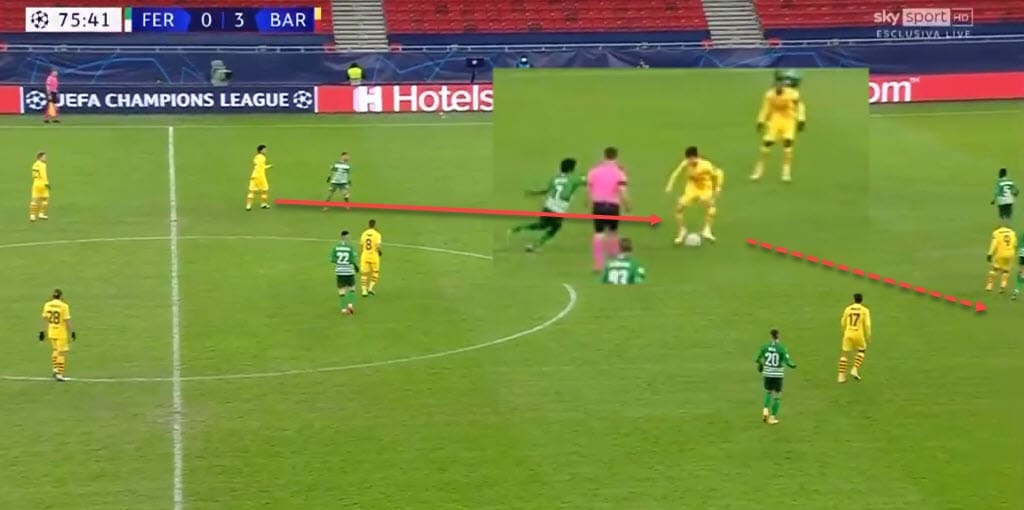
In the image above, you can see Puig positioned between the lines as he receives another pass from his teammate. This time, however, he opens up his body and lets the ball slide to his left foot, immediately sending it towards the box for a progressive run.
This turn of the shoulder is something of a signature move and can be utilised to quickly advance up the pitch and/or beat the marker. The following example will demonstrate the latter case perfectly.
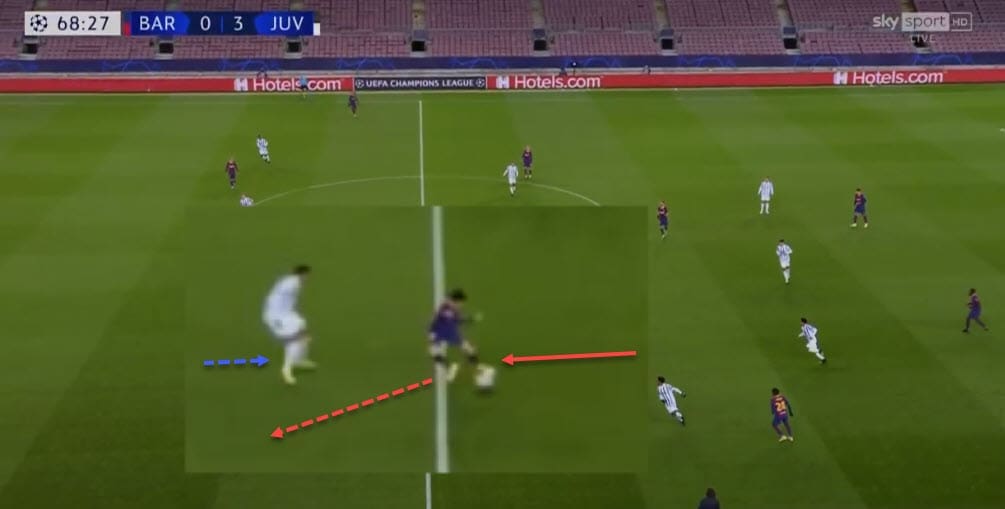
Puig receives the ball from the deep, which prompts the defender to step out of his position and challenge for the ball. However, since the youngster can suddenly open up his body to direct the ball towards his next destination, the defender doesn’t expect him to turn so effectively.
This move removes the defender entirely and he’s forced to make a tactical foul to stop the youngster from escaping. What makes it so efficient is that the opposition don’t expect Puig to move so quickly upon receiving as he makes as few touches as possible before deploying a pass.
Even players like De Jong and especially Coutinho struggle with this aspect and take too many touches, resulting in the play being slowed down instead of accelerated. This is what makes Puig so effective in switching play and recycling the ball towards a less crowded area. He can receive and deploy a pass quicker than most.
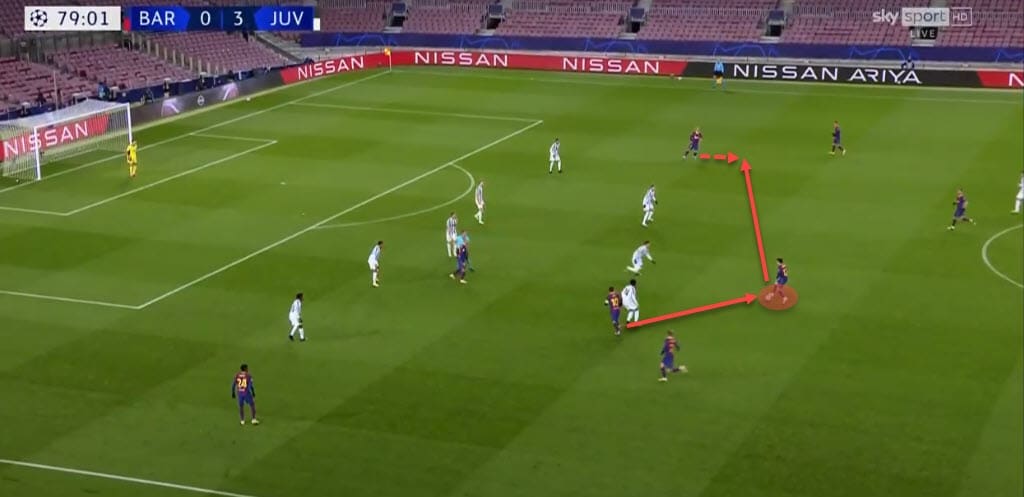
We’ve already seen him do something similar to the above example but here against Juventus, Puig receives the pass from Messi and in two touches, he’s already away from the marker who pushes out and switches side quickly. This move ensures Barcelona can recycle possession more efficiently but it also disrupts the opposition’s shape because it creates pockets for the attackers to occupy between the lines after a defender moves out.
But this positioning outside of the defensive block is something Puig often does as well. While usually we’d see him between the lines where he can use the turn of the shoulder to burst towards the box, in this scenario he can use his body orientation to disguise a line-breaking pass.
In the example below, we first see him receive the ball in an optimal shape once more, opening his body as the pass is being delivered towards him, and immediately turning towards the path he wants to take next.
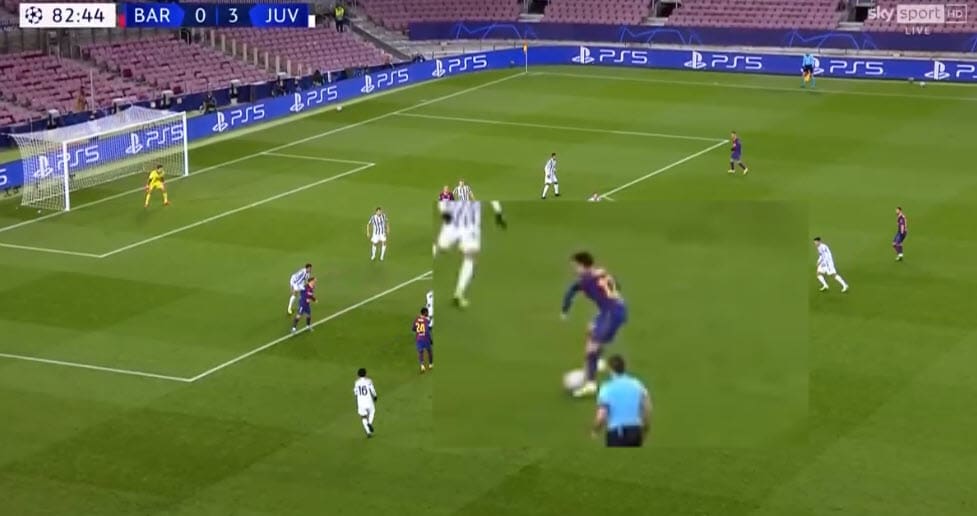
Just like before, his movement attracts the attention of multiple defenders who step out to challenge for the ball. But Puig’s orientation makes them believe he’ll continue towards the right flank and just switch play once the opportunity arises.
The midfielder, however, disguises his pass and instead opts to break the lines and find Messi in zone 14, completely unmarked.
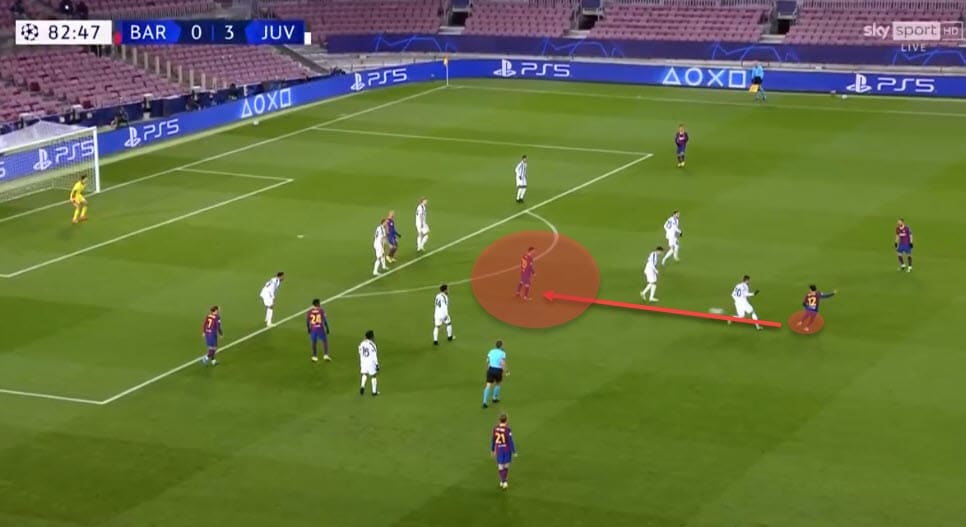
This is the kind of proactivity and creativeness other Barcelona midfielders aren’t showing at the moment.
Runs into the danger area
With the lack of an attacking presence in the danger areas, Koeman often instructs De Jong to make a late run into the box. The Dutchman is efficient at it, even bagging a goal through these very same tactics against Huesca as well.
However, apart from him, Barcelona don’t seem to have anyone offering a similar output. Puig, however, could be the solution once more. We can often see the youngster rushing towards the danger area either with or without the ball, progressing the play or opening/ exploiting passing channels.
He may not score or assist plenty of goals but his work in the build-up and creation should not be disregarded, as evidenced by the initial graphs in this tactical analysis. Below, you can see an example of his transition from the usual between the lines positioning to bursting into the final third.
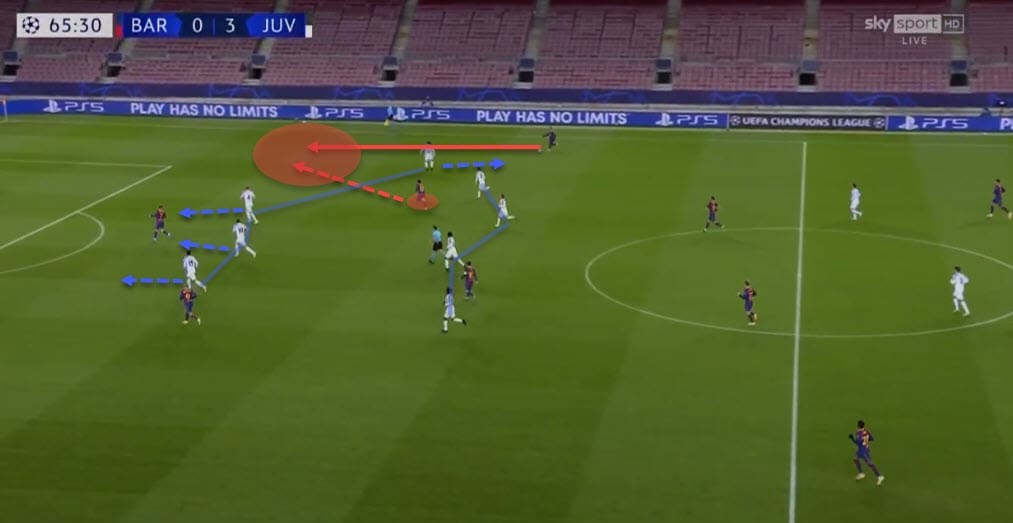
Since both Griezmann and Martin Braithwaite have decided to drift inward, dragging the markers as well, Puig decides to exploit the space towards the right fank by making a surging run from the deep.
This kind of movement is crucial when Barcelona lack a presence either out wide or in the box, depending on the situation. When it comes to the latter, Puig is often the one to ensure others get into favourable positions rather than finishing the actions himself.
Below, you can see such an example as he enters the box first and uses his run as a decoy so that the defender is pulled away and a passing channel towards Coutinho opened.
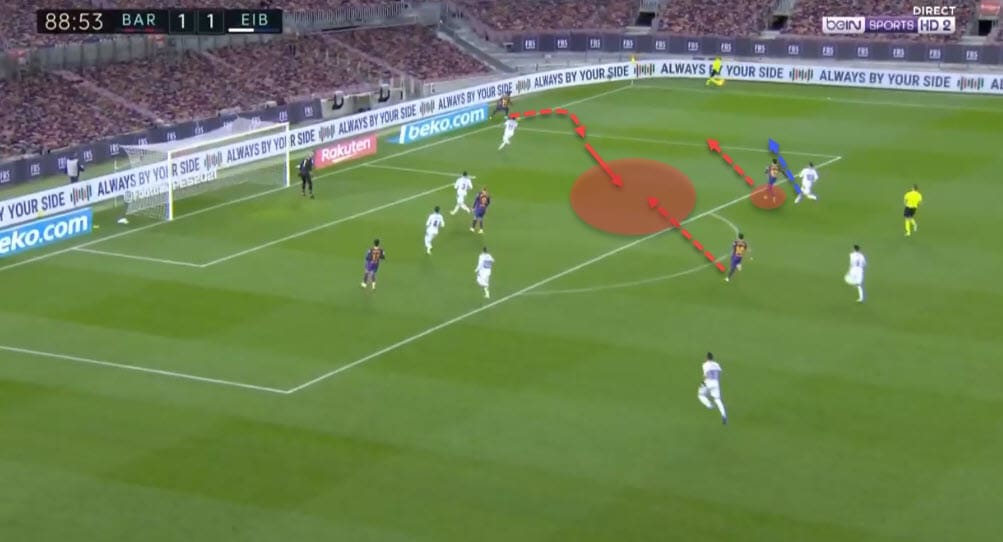
Of course, since he doesn’t offer much in terms of pure goal-scoring and lethality, which Barcelona are currently lacking severely, this could also be seen as a weakness of sorts. At the moment, Koeman needs decisiveness in front of goal and that could be part of the reason why he doesn’t opt to play Puig as much.
But with him on the pitch, Barcelona are faster, more creative and more unpredictable, which results in more frequent and overall better chances.
Conclusion
Puig is not a flawless player nor can he immediately turn Barcelona into world-beaters once again. However, his player profile does offer a solution to many of Koeman’s problems, namely destabilising a low block and acceleration of play.
He is highly intelligent and technical, a prototype Barcelona midfielder if you will. This tactical analysis sought to highlight some of his traits that could benefit Koeman’s tactics and give the Catalans a better chance for the remainder of the season.





Comments